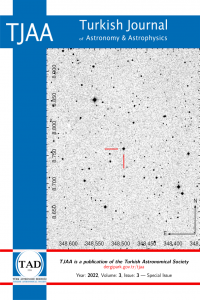Abstract
Bu çalışmada, kuazarlarda kırmızya kaymanın belirlenmesi amacı ile geliştirilen "zFinder" otomatik program dizgesinin algoritması ve sonuçları sunulmuştur. Literatürdeki birçok çalışmada kırmızıya kayma (z) çapraz korelasyon metodu ile belirlenmektedir. Bu çalışmada Spearman korelasyonu ve Ki-Kare metotlarından yararlanılarak yeni bir uyumluluk parametresi geliştirilmiştir. Geliştirilen uyumluluk parametresi, tayfın süreklilik ve salma çizgilerinin uyumluluklarını birlikte gözeterek olası korelasyon hatalarını önlemektedir. zFinder programının test edilmesi amacıyla SDSS DR16Q kataloğundan 150 kuazar seçilmiştir. Programın çıktıları, SDSS'in otomatik program dizgesi "spec1d" çıktıları ile kıyaslanmıştır. Sonuç olarak farkların mutlak ortalaması "0.0018" ölçülmüştür. Sonuçlar genel olarak uyumlu olmakla birlikte, SDSS'in "z=6.48" ölçtüğü bir kuazar için zFinder programı ile "z=0.38" ölçülmüştür. Tayfın incelenmesi sonucunda, zFinder programı ile elde edilen değerin doğru değer olduğu görülmüştür.
References
- Referans1: Bolton A. S., et al., 2012, AJ, 144, 144
- Referans2: Busca N., Balland C., 2018, preprint, (arXiv:1808.09955), ADS Referans3: Hewett P. C., Wild V., 2010, MNRAS, 405, 2302
- Referans4: Hubble E., 1929, Proceedings of the National Academy of Science, 15, 168
- Referans5: Lyke B. W., et al., 2020, ApJS, 250, 8
- Referans6: Padovani P., et al., 2017, A&ARv, 25, 2
- Referans7: Savitzky A., Golay M. J. E., 1964, Analytical Chemistry, 36, 1627, ADS
- Referans8: Schneider D. P., et al., 2010, AJ, 139, 2360
- Referans9: Soltis J., Casertano S., Riess A. G., 2021, The Astrophysical Journal Letters, 908, L5
- Referans10: Spearman C., 1987, The Proof and Measurement of Association between Two Things, http://www.jstor.org/stable/1422689
- Referans11: Tonry J., Davis M., 1979, AJ, 84, 1511
- Referans12: Vanden Berk D. E., et al., 2001, AJ, 122, 549
- Referans13: Wall J. V., 1996, QJRAS, 37, 519, ADS
Abstract
This study presents the algorithm and the test results for the zFinder pipeline code that is developed to measure the redshift (z) of the quasar spectra. The methodological approach of the zFinder code considers both the and Spearman parameters to define the accordance parameter where majority of the existing studies adopt the cross-correlation. The approach of comparing the entire observed spectra with a quasar template increases the precision of the measured z value by examining both the continuum and the strong lines on each spectra. We test the "zFinder" results for 150 quasars selected from SDSS DR16 quasar catalog of which z values are measured by spec1d pipeline of SDSS. We show that the z values are in a general agreement with and the average difference between zFinder and is "0.0018". There is one quasar spectra with measurements of "z=6.6.48" from "spec1d" and "z = 0.38" from "zFinder". Further investigations of the spectra showed that the "zFinder" gives the more accurate value of "z" and the "spec1d" misclassified the strong emission lines of the quasar.
References
- Referans1: Bolton A. S., et al., 2012, AJ, 144, 144
- Referans2: Busca N., Balland C., 2018, preprint, (arXiv:1808.09955), ADS Referans3: Hewett P. C., Wild V., 2010, MNRAS, 405, 2302
- Referans4: Hubble E., 1929, Proceedings of the National Academy of Science, 15, 168
- Referans5: Lyke B. W., et al., 2020, ApJS, 250, 8
- Referans6: Padovani P., et al., 2017, A&ARv, 25, 2
- Referans7: Savitzky A., Golay M. J. E., 1964, Analytical Chemistry, 36, 1627, ADS
- Referans8: Schneider D. P., et al., 2010, AJ, 139, 2360
- Referans9: Soltis J., Casertano S., Riess A. G., 2021, The Astrophysical Journal Letters, 908, L5
- Referans10: Spearman C., 1987, The Proof and Measurement of Association between Two Things, http://www.jstor.org/stable/1422689
- Referans11: Tonry J., Davis M., 1979, AJ, 84, 1511
- Referans12: Vanden Berk D. E., et al., 2001, AJ, 122, 549
- Referans13: Wall J. V., 1996, QJRAS, 37, 519, ADS
Details
| Primary Language | Turkish |
|---|---|
| Subjects | Astronomical Sciences (Other) |
| Journal Section | Research Article |
| Authors | |
| Publication Date | December 31, 2022 |
| Submission Date | December 15, 2021 |
| Acceptance Date | January 11, 2022 |
| Published in Issue | Year 2022 Volume: 3 Issue: 3 |
Cited By
Discovery of Six Low-z, High-luminosity, and High-mass Quasars
Publications of the Astronomical Society of the Pacific
https://doi.org/10.1088/1538-3873/ad8b6b
RTT-150 ile 6 Düşük-z Kuazarın Tayfsal Doğrulaması
Turkish Journal of Astronomy and Astrophysics
https://doi.org/10.55064/tjaa.1632477
TJAA is a publication of Turkish Astronomical Society (TAD).

